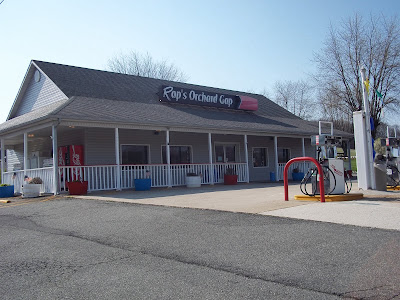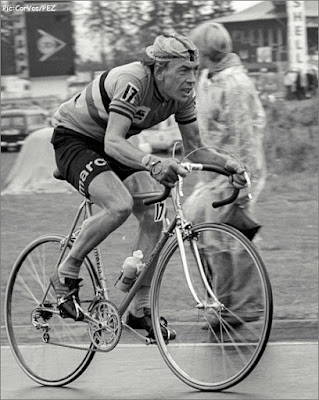bicycle, cycling, commuting by bicycle, mountain bike, riding bicycles, group ride, power tap, bike racing, bmx
Friday, April 29, 2011
Tuesday, April 26, 2011
Monday, April 25, 2011
Sunday, April 24, 2011
Lucien Buysse
Lucien Buysse (September 11, 1892 - January 3, 1980) was a Belgian cyclist and a champion of the Tour de France.
Born in Wontergem, Buysse began racing professionally in 1914, when he entered the Tour de France but did not finish. He resumed his career after World War I, entering but abandoning the Tour again in 1919 but placing third in Paris-Roubaix in 1920. In 1923 he completed the Tour de France and finished in eigth place. In the 1924 and 1925 Tours, he rode with the Italian Automoto team led by Ottavio Bottecchia, where he was perhaps the first domestique in the history of the Tour. He placed third in 1924 and second in 1925.
The 1926 Tour was the longest in history (5,745 km), with 17 stages averaging 383 km. Buysse, racing with his two brothers, Jules and Michel, took the yellow jersey from Gustave Van Slembrouck on stage 10 by attacking during a furious storm on the Col d'Aspin in the Pyrenees. He gained almost an hour during the stage over his team leader Bottecchia who then abandoned. Buysse arrived in Paris as the champion.
Buysse won a total of five stages of the Tour during his career: one in 1923; two in 1925 and two in 1926.
Saturday, April 23, 2011
Friday, April 22, 2011
Thursday, April 21, 2011
Tuesday, April 19, 2011
Rik Van Steenbergen
Rik Van Steenbergen was born September 9, 1924 in Arendonk to a poor family. He worked as an errand boy and a cigar-roller. He began racing at 16 and became one of Belgium's best juniors from 1940 to 1942.
He started cycling as a professional during World War II in 1942. The next year he won his first important races, and became Belgian road cycling champion. In 1944, he won the Ronde van Vlaanderen Classic, which he won again two years later.
During his career, which lasted until 1966, Van Steenbergen won several more classics: Paris-Roubaix, Paris-Brussels and Milan-San Remo. He also won the World Road Cycling Championships three times, equaling the (still standing) record of Alfredo Binda. His last world title, a year after his second, was won in front of a home crowd. In addition, he placed third in the first post-war championships in 1946.
Van Steenbergen also excelled on the track, and won 40 Six-day events. His track capabilities made him an excellant road sprinter. However, he usually had difficulty climbing, which prevented him from winning major stage races. He nevertheless placed 2nd in the 1951 Giro d'Italia. Some suggest he could have competed for victory in stage races had he concentrated on them, instead of racing almost every race he could enter. It is estimated Van Steenbergen won slightly fewer than 1,000 races, though accounts differ widely.
He started cycling as a professional during World War II in 1942. The next year he won his first important races, and became Belgian road cycling champion. In 1944, he won the Ronde van Vlaanderen Classic, which he won again two years later.
During his career, which lasted until 1966, Van Steenbergen won several more classics: Paris-Roubaix, Paris-Brussels and Milan-San Remo. He also won the World Road Cycling Championships three times, equaling the (still standing) record of Alfredo Binda. His last world title, a year after his second, was won in front of a home crowd. In addition, he placed third in the first post-war championships in 1946.
Van Steenbergen also excelled on the track, and won 40 Six-day events. His track capabilities made him an excellant road sprinter. However, he usually had difficulty climbing, which prevented him from winning major stage races. He nevertheless placed 2nd in the 1951 Giro d'Italia. Some suggest he could have competed for victory in stage races had he concentrated on them, instead of racing almost every race he could enter. It is estimated Van Steenbergen won slightly fewer than 1,000 races, though accounts differ widely.
Keirin: High Speed Racers
Keirin: Speed Racers on Nowness.com.
Inside the High-Octane and Lucrative World of Japan's Cycling Spectacle
Before fixed-gear bikes became de rigueur for urban aesthetes, they were the weapon of choice for Japan's fearless Keirin cyclists. A gladiaorial incarnation of track cycling that dates back to 1948, the Japanese sporting phenomenon operates by an intricate set of rules that sees competitors jostling for position on steeply banked tracks at lighting fast speeds, all but encouraging spectacular crashes. In today's film for NOWNESS, Jonathan de Villiers (whose fashion photography and portraiture has appeared in The New York Times Magazine, Wallpaper and Fantastic Man) traveled to the national Keirin school in Tokyo and the Tachikawa and Yokkaichi velodromes to decode the strategy that governs the racing phenomenon. "I knew next to nothing about it when I went, "says de Villiers, "but I'm a big admirer of the anthropological documentary where you get taken into a whole different world. and what a strange, special and complex universe it turned out to be." The state-run industry amasses tens of billions in gambling revenue each year.
Monday, April 18, 2011
Eddy Merckx - Hour Record 1972 Mexico City

This is the bike that Eddy Merckx set the hour record on in 1972. It was specially constructed for him by Colnago using a custom track frame and special components and accessories designed to provide the maximum in light weight. It weighed only 12.68 pounds or 5.75 kilograms. Many of the elements , such as the handlebar, bottom bracket shell, and crankarms were milled to make them even lighter. The headset was made by Campagnolo with titanium caps and weighed only 122 grams. The pedals and hubs were made of Soviet-source beryllium.

Merckx set the hour record in 1972. On October 25th, he covered 49.431km at high altitude in Mexico City. The record remained untouched until 1984, when Francesco Moser broke it using a specially designed bicycle with meticulous improvements in streamlining. Over 15 years, various racers improved the record to more than 56 km (Chris Boardman). However, because of the increasingly exotic design of the bikes and position of the rider, these performances were no longer reasonably comparable to Merckx's achievement. In response, the UCI in 2000 required a "traditional" bike to be used. When Boardman had another go at Merckx's reinstated record 28 years later, he beat it by slightly more than 10 meters at sea level. On the other hand, Merckx had raced a full road season winning the Tour, Giro and four Classics, while Boardman was a time trial specialist who had retired from road racing and had prepared specifically for the 2000 Hour Record.
Adventure ride with The Salem Lake Trail thrown in for fun
The Salem Creek Greenway is right by Old Salem and it takes you all the way to The Salem Lake Trail with no cars to deal with. It was a nice day to ride. Part of the Greenway was a little under water, but that was no real problem.
The city is in the process of draining the lake and rebuilding the dam. They have done an amazing amount of work to make sure you can still go all the way around the lake. A new section of paved Greenway has even been added to be sure folks can still enjoy the facility. This is a great asset to the community and very enjoyable even with the lake drained down.
 |
| Part of the drained section of Salem Lake. |
I sort of forgot to take it easy since I had road tires on my bike. Fortunately they held up great and didn't slide at all in the corners. The Salem Lake Trail is a great place to run, walk or ride your bicycle. It's Seven miles for one lap around Salem Lake, so riding your bike is best.
 |
| My bike on the Trail
After riding a couple of laps around Salem Lake I headed home. This ride was about fifty miles with the few detours that I took riding to and from the lake.
|
Sunday, April 17, 2011
Tuesday, April 12, 2011
Sunday, April 10, 2011
Mt. Airy to the top of Orchard Gap and Back, an old favorite of many local cyclists
 |
| Click on the images to enlarge them |
My ride started on the Emily B. Taylor Greenway in Mt. Airy, NC. I always enjoy riding on this greenway and there is public parking available. If you drive into Mt. Airy on Highway 52 from the south you will be able to see the greenway to your right. |
 |
| A section of the greenway |
 |
| There are markers every 1/4th mile so walkers and cyclists will know just exactly how far they have been. |
 |
| This is the last bridge of my greenway ride. Here the greenway runs into W. Lebanon St. Turn right here to begin working your way out of Mt. Airy. |
 |
| Just under six miles into the ride you will cross from North Carolina into Virginia on Ward's Gap Road. |
 |
| A view off to the right of Ward's Gap Road |
 |
| Looking to the left on Ward's Gap Road you will see this orchard of apple trees. |
 |
| A section of the road on the climb up Orchard Gap |
 |
| Another section of the climb |
 |
| The store at the top of Orchard Gap. Unfortunately it was closed today. |
 |
| Here I am on Ground Hog Mountain Road. I took this photo using the timer on my camera. It turned out blurry, but I included it anyway. |
Posted b
Herman van Springel - Mr. Bordeaux-Paris
 |
| Herman van Springel |
Herman van springel (born August 14, 1943) is a Belgian former road racing cyclist, from Grobbendonk, in the Flemish Campine or Kempen region.
He was an accomplished time-trial rider, almost winning the Tour de France in 1968, when he was beaten in the last stage by Dutchman, Jan Janssen in a time-trial. (he lost the tour by 38 seconds) In the autumn of that year, he won the classic Giro di Lombardia.
Herman won seven editions of the marathon Bordeaux-Paris. Winning years in this race were: 1970, 1974, 1975, 1977, 1978, 1980 and 1981. No other rider comes close to his record at this race.
Van Springel's pro bicycle racing career was from 1965 through 1981. He had around 145 pro victories to his credit.
Bordeaux-Paris
The Bordeaux-Paris professional bicycle race was one of Europe's Classic Races, and one of the longest in the professional calendar, covering approximately, 560km (350 miles) - more than twice most single-day races. It started in northern Bordeaux in south-west France at 2am and finished in the capital Paris about 14 hours later.
The event was first run on May 23, 1891, and the Derby of the Road as it was sometimes called, was notable in that riders were paced - allowed to slipstream - behind tandem or conventional cycles. From 1931, pacing was by motorcycles or small pedal-assisted Dernys. Pacing was also briefly by cars. In early events, pacing was provided from Bordeaux. In later events, it was introduced part-way towards Paris. From 1946 to 1986, more than half the distance was paced, Dernys being introduced at Poitiers or Chatellerault, roughly half-way. The final edition of the race was held in 1988.
 |
| Herman van Springel in Molteni Jersey |
Saturday, April 9, 2011
Subscribe to:
Posts (Atom)






































